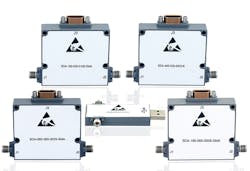Accessories Add Up to Better Measurements
Purchasing a test instrument is a major investment—it’s no exaggeration to say that the future of a company may ride on that instrument’s capabilities. Measurements don’t begin and end with the instrument, however; they may also depend on such things as instrument cables. Especially with an RF/microwave vector network analyzer (VNA), accessories such as sliding shorts and the aforementioned test cables can make or break a measurement. Compared to the cost of a VNA, they are well worth the added costs.
What kind of test accessories can be beneficial, and why? Some of the most basic test accessories are used for extending the amplitude range presented to a device under test (DUT), like attenuators for decreasing signal levels (and amplifiers for increasing them). Attenuators for test purposes come in three varieties: fixed with a single attenuation value, continuously variable over a range of attenuation, and adjustable in discrete steps over a range of attenuation. Step attenuators are available with digital control ports—such as RS-232, GPIB, and USB ports—for computer control in automatic-test-equipment (ATE) setups. In contrast, fixed attenuators may be switched in and out of a test setup by hand and continuously variable attenuators require manual tuning.
Depending on the test, a single, fixed attenuation value such as 10 or 40 dB might be all that is needed to reduce the levels of a test signal to a receiver for sensitivity testing. In a step attenuator, the number of steps determines the resolution, but will also require more than to perform a measurement over a given attenuation range if all the steps are used compared to an attenuator with larger steps (and less resolution). Continuously variable attenuators allow for tuning to attenuation values not possible with a step attenuator, but with careful, manual adjustments.
A well-equipped test bench usually has a “measurement toolbox” close at hand containing a fair share of passive components for measurement accessories. In addition to attenuators and cables, these include adapters, couplers, DC blocks, filters, and power combiners/dividers. As with the other test accessories, the nature of a test will set the required frequency range. That being said, if measurements include harmonics and out-of-band spurious signals, these additional signals should be taken into consideration when adding a passive test accessory to the measurement toolbox.
Active components used as test accessories, such as low-noise preamplifiers, may be among the most difficult components to design and to specify. For a test such as receiver sensitivity, for example, not only should the preamplifier exhibit a relatively low noise figure, it should also muster a decent amount of gain and healthy output power. It is typically difficult to optimize transistor matching circuitry for gain and power, let alone low noise figure. In addition, amplifiers designed for use as accessories with broadband test instruments—such as spectrum analyzers and VNAs—must provide that difficult combination of performance parameters across wide frequency ranges, and sometimes through millimeter-wave frequencies.
These are just a few examples of test accessories that become important tools in day-to-day RF/microwave measurements. Sometimes it’s simply a coaxial adapter that can make it so much earlier to perform a measurement on a DUT. Or it may be that favorite test probe that makes it possible to measure the voltage at a particularly hard-to-reach part of a circuit board. It may even be a torque wrench that makes an accurate measurement possible. Yes, the instruments may be costly, but for a little bit more, test accessories can help make better measurements.
About the Author
Jack Browne Blog
Jack Browne, Technical Contributor, has worked in technical publishing for over 30 years. He managed the content and production of three technical journals while at the American Institute of Physics, including Medical Physics and the Journal of Vacuum Science & Technology. He has been a Publisher and Editor for Penton Media, started the firm’s Wireless Symposium & Exhibition trade show in 1993, and currently serves as Technical Contributor for that company's Microwaves & RF magazine. Browne, who holds a BS in Mathematics from City College of New York and BA degrees in English and Philosophy from Fordham University, is a member of the IEEE.


